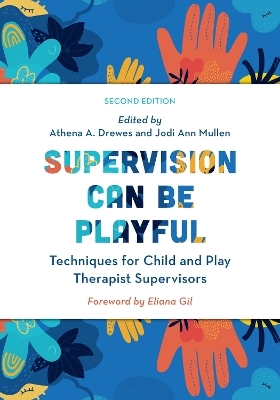
Supervision Can Be Playful
Rowman & Littlefield (Verlag)
978-1-5381-6746-5 (ISBN)
This book offers a unique perspective on clinical supervision, foregrounding experiential techniques and offering a refreshing, playful approach to professional development.
Supervision Can Be Playful: Techniques for Child and Play Therapist Supervisors, Second Edition offers a holistic approach covering contextual factors, theory, practice, special topics, international voices, practical support, supervisor and supervisee self-care, and play within supervision itself. This book balances theory-driven chapters with intervention-driven chapters offering hands-on, creative methods for specialty supervision in play therapy, and speaks from the “experience of clinical supervision.” This volume is useful for training, teaching, and clinical supervision with clearly organized and logically-positioned chapters, to provide educational and practical support for clinicians and supervisors from beginning levels to the most experienced supervisor.
The overall approach to this second edition demonstrates in-depth knowledge and understanding of the specialist demands of supervision for child therapists. The editors are themselves internationally renowned practitioners and they have brought together practitioners and educators recognized in the field to contribute from their expertise. The structure of the book addresses key issues in complementary sequence that builds up the reader's knowledge and understanding of the multi-faceted layers that can support truly interpersonal, creative, and culturally sensitive supervision. The chapters have been carefully considered and are inclusive, contemporary, comprehensive and practitioner-friendly.
Contributors: Jeffrey S. Ashby, Jessika Boles, Sue C. Bratton, Yi-Ju Cheng, Heather Coull, Janet Courtney, David A. Crenshaw, Sarah Daniels, Belinda Dean, Lennis G. Echterling, Lyrica Fils-Aime, Ken Gardner, Phoebe Godfrey, Paris Goodyear-Brown, Robert Grant, Natalie Hadiprodjo, Cary Hamilton, Lesley Harvey, Sarah Hickson, Linda E. Homeyer, Sue Jennings, Vanessa Kellner, Sueann Kenney-Noziska, Simon Kerr-Edwards, Terry Kottman, Jamie Langley, Ariel Marrero, Mary Morrison Bennett, Claire Niven, Yumiko Ogawa, Kristie K. Opiola, Judi Parson, Dee C. Ray, Kate Renshaw, Bridget Sarah, Karen Stagnitti, Anne Stewart, Alyssa Swan, Kaleb A. Thompson, Rise Van Fleet, Marieke van Nuenen, William F. Whelan, Lorri Yasenik, Zhou De-Hui Ruth About the Editors: Athena A. Drewes, PsyD, MA, RPT-S, is a licensed psychologist, certified school psychologist and Registered Play Therapist and Supervisor. Formerly Director of Training and Director of the American Psychological Association Doctoral Psychology Internship at Astor Services for Children and Families in New York, she currently lives in Ocala, FL. She has over 45 years of clinical and supervision experience with complex trauma, sexual abuse, foster care children and adolescents, in school, outpatient and inpatient settings. She is former Board of Director of the Association for Play Therapy and Founder and President Emeritus of the NY Association for Play Therapy. She is a frequently invited guest lecturer around the United States and internationally around the world, including Argentina, Australia, Canada, China, Denmark, England, Ireland, Italy, Mexico and Taiwan. She is a renowned writer of play therapy and has published numerous book chapters, journal articles and edited/co-edited twelve play therapy books. Her most recent books are Play-based interventions for childhood anxieties, Fears, and phobias; Puppet play therapy; Play therapy in middle childhood with a companion DVD of Dr. Drewes demonstrating her work in Prescriptive Integrative Play Therapy with the American Psychological Association; and co-edited with Dr. Charles Schaefer The Therapeutic powers of play. 20 Core agents of change. Jodi Ann Mullen, PhD, LMHC, RPT-S is a professor at SUNY Oswego in the Counseling & Psychological Services Department and the coordinator of the Graduate Certificate Program in Play Therapy. She is also the Director of Integrative Counseling Services in Central New York. Dr. Mullen is an international speaker, author, credentialed play therapist and play therapy supervisor. She routinely provides clinical supervision and consultation for clinicians from across the United States and from Ireland, Australia, England, Jamaica, and Canada. Dr. Mullen has over 25 years of experience in the field of counseling and play therapy. She has authored books, book chapters and journal articles in play therapy, counseling children and adolescents, grief counseling and parenting. Dr. Mullen is a former clinical editor for the Play Therapy magazine and was the 2008 recipient of the Key Award for Professional Training & Education through the Association for Play Therapy.
Foreword – Eliana Gil
Introduction – Mullen & Drewes
Part I: Groundwork and Foundations
Chapter 1: Through a Cultural Lens: How Viewing Childhood as a Distinct Culture Impacts Supervision – Jodi Ann Mullen
Abstract
The Shift
Case Study: Rowan
Defining the Culture of Childhood
Assessing Supervisees’ Cross-Cultural Skills
How to Honor the Culture of Childhood in Mental Health
Conclusion
References
Chapter 2: Consideration of Child Development in Play Therapy and Supervision – Athena Drewes
Abstract
Developmental Models
Erik Erikson (1963) – Maturational-Developmental Theory
Jane Loevinger (1976) – Ego Development
Jean Piaget (1932/1965) – Cognitive Theory
Lawrence Kohlberg (1987) – Moral Development
Lev Vygotsky (1966) – Cognitive Development Theory
Stanley Greenspan (1993) – Emotional Development
Sigmund Freud (1905) – Psychosexual Development
Sue and Sue (2003) – Racial/Cultural Identity Development
Special Considerations
Assessing Cognitive-Developmental Level
Impact of Trauma on Development
Sexualized Behavior: Normal Development vs Abuse
Case Example
Conclusion
References
Chapter 3: Where the Personal and Professional Meet: Consideration of Attachment Dynamics in Play Therapy Supervision – Simon Kerr-Edwards
Abstract
Theoretical Approach
Relevant Research
Unique Aspects and Challenges of Supervision
Incorporating Experiential Elements in Supervision
Exercises
1. Attachment History and Patterns
Rationale
Attachment Constellation
Materials
Instructions
Reflection
2. Secure Base and Safe Haven
Rationale
Design Your Own Supervision Space
Materials
Exercise
Instructions
Reflection
Storm Shelter
Materials
Exercise
Instructions
Reflection
Working Alliance
Rationale
Supervision Jigsaw
Materials
Exercise
Instruction
Reflection
Conclusion
References
Chapter 4: Integrating the Use of Placement and Assessment Review (PAR) in Play Therapy Supervision – Bridget Sarah, Kate Renshaw, Natalie Hadiprodjo, Phoebe Godfrey, and Judi Parson
Abstract
Introduction
What Are Competencies?
Competencies in Play Therapy
Introducing the Placement Assessment and Review (PAR)
Development of the Placement Assessment and Review (PAR)
The What, How and Why of the Placement Assessment and Review
The Supervisory Relationship
Domain A: Links Theoretical Knowledge to Inform Play Therapy Practice
Domain B: Reflects on Clinical Play Therapy Practice and Therapeutic Skills
Domain C: Demonstrates Professional Practice and Conduct
Further Applications and Considerations
Conclusion
Recommended Resources
References
Chapter 5: When Approaches Collide: New Insights Using the Play Therapy Dimensions Case Conceptualization Tools – Ken Gardner and Lorri Yasenik
Rationale for a Defined Play Therapy Supervision Model
The Play Therapy Dimension Model
Decision-Making Using the Four Quadrants
Developmental Framework for Supervision
Avoiding Collision Points in Play Therapy: Supervision Mechanisms and Tools
Child and Therapist Moderator Factors Scale
Therapist Degree of Immersion Scale
Case Vignette
Jolene
Summary
References
Part II: Growing Supervisees and Supervisors
Chapter 6: International Supervision for Play Therapy Practice: Navigating the Translatable – Judi Parson, Sarah Hickson, Belinda Dean, and Ruth Zhou
Abstract
Introduction
Supervision Definition
Models of Supervision
Humor in Supervision
Ethical Considerations
Setting the International Supervision Scene
Your Time or Mine
Additional Considerations for International Supervision Contracts
Resources
Navigating the Narrative
Background
Presenting Issues
Aims and Objectives of Play Therapy
Themes
Progress
First sessions
Supervision
Middle sessions
Supervision
End sessions
An Aesthetic Response to Tommy’s Story and the Process of the International Supervision
Conclusion
Key Readings
Additional Resources
References
Chapter 7: Climbing the Ladder: The Unique Challenges of Supervision of Supervision – Athena A. Drewes
Abstract
Introduction
Supervision of Supervision
Supervisor Competencies
Regulatory Requirements
Defining Supervision of Supervision and Its Levels
Boundaries
Mirror Effect
Setting Clear Goals
Difference and Power in Supervision
Research
Case Example
Conclusion
References
Chapter 8: Techniques to Unlock the Creative Potential of Play Therapist Supervisors – Jamie Langley
Abstract
Creative Potential
Exploring the Keys
Get Up and Move
Spend Time in Nature
Listen to Music
Engage in Mindfulness Practice
Seek Sanctuary, Silence, and Stillness
Get Some Rest
Just Do It
Creativity Unlocked
References
Chapter 9: Playful Supervision: Sharing Attachment-informed Exercises in the Supervision of Play Therapists – Anne Stewart, William F. Whelan, and Lennis G. Echterling
Supervision and Play Therapy
Caregiving and Effective Supervision
Attachment Security as a Guide to Secure Supervision
Attachment-Informed Exercises
Safe Haven Needs
Sensory Mapping
Pocket Pals
Mindful Walk
Secure Base Needs
Getting to Know You
Cultural Collage
Coregulation
Original Work
Supervisionland
Tag Team Role Playing
Reflective Functioning
Drawing Together
Quotes
Inkshedding
Storytelling
Conclusion
References
Chapter 10: Supervision: Seeing Ourselves and Clients in the Sand – Mary Morrison Bennett and Linda E. Homeyer
Abstract
Supervision in the Sand Tray
Model of Supervision
Sand Tray as a Supervisory Intervention
Experiential Sand Tray Activities
Understanding the System
Understanding their World
Compare and Contrast
Understanding Parents
Understanding the Session
Understanding Your Professional Development
Play Genograms
Resistant Supervisees
Processing Sand Tray in the Supervision Session
Research
Conclusion
References
Part III: Critical Building Blocks
Chapter 11: Multicultural Supervision: Building Culturally Responsive Play Therapists – Lyrica Fils-Aime
Children See Inequities
What is Multicultural Supervision?
Why Focus on Race in Play Therapy Supervision
Developing an Equity Lens as a Play Therapist
Unconscious Bias
Colorblindness Bias
Deficit Thinking
Supervision across Similar Identities
How Does Racism Impact Children?
Supervision across Difference
Goals for Supervisees
A Culturally Responsive Play Therapist
References
Appendix 1
Appendix 2: Recommended Reading to Keep Learning
Appendix 3
Chapter 12: The “Good” Clinician: A Steep Learning Curve—Beyond Good to Culturally Safe – Claire Niven, Heather Coull, Lesley Harvey, and Judi Parson
Abstract
Author Introductions
Introduction
Is It Safe?
Conclusion
Recommended Resources
References
Chapter 13: Developing Cultural Humility: Play-based Techniques for Supervisors – Ariel Marrero
What is Cultural Humility?
Research on Cultural Humility
The Difference Between Cultural Competence and Cultural Humility
Cultural Humility in Supervision
The Supervisor-Supervisee Relationship
Conversations about Culture
Supporting Supervisee Self-Reflection
Using Play-Based Techniques in Supervision
Cultural Humility Map
Tough Conversation Puppet Show
Cultural Ruptures in the Sand
Past, Present, and Future Self
Conclusion
References
Chapter 14: Ethical and Social Justice Considerations in Play Therapy Supervision – Jeffrey S. Ashby and Marieke van Nuenen
Autonomy
Nonmaleficence and Beneficence
Justice
Conclusion
References
Chapter 15: Supervising on the Global Stage: Unraveling the Stories or the Layering of Intimacy – Sue Jennings
Abstract
Models of Supervision Practice
Neuro-Dramatic-Play (NDP)
Theater of Resilience (ToR)
The Supervisory Mandala
The Story of Markandeya (Adapted from the Mahabharata)
References
Part IV: Working with Parents, Families, and Groups
Chapter 16: Group Supervision of Group Filial Therapy: Playing with Symbols and Metaphor to Foster Self-Awareness – Sue C. Bratton, Alyssa Swan, and Kristie K. Opiola
Abstract
Group Supervision of Group Filial Therapy: Playing with Symbols and Metaphor to Foster Self-Awareness
Supervision Model
Importance of Self-Awareness
Group Supervision
Incorporating Expressive Media
Role of the Supervisor in Presenting Expressive Media
Example Experiential Activity
Objectives
Activity: Sand Tray
Materials and Set-up
Structure
Processing Prompts
Adaptations
Unique Aspects and Challenges
Conclusion
References
Chapter 17: The Van Fleet Collaborative Model of Supervision: It’s All About the Relationship – Rise Van Fleet
Abstract
Theoretical Approach
Background
Influences on Supervision Approach
The VanFleet Collaborative Model of Supervision
Supporting Principle of the Collaborative Model
Standard Aspects of Supervision
The Process of the Collaborative Model
Supervisee Case Presentation
Supervisor Responds to this Information
Supervisee Shares Ideas and Plans for Future Sessions
Supervisor Responds, and Shares Suggestions and Ideas for the Next Several Client Sessions
Supervisor Invites and Manages Other Ideas and Suggestions from the Group (if Group Supervision)
Supervisee Gives Reactions to Suggestions Made
Supervisor and Supervisee Jointly Develop Action Plan, and Follow-Up Plan in Future Supervision Meetings
Guidelines for Giving Feedback
Relevant Research
Unique Aspects and Challenges of Supervision
Experiential Elements of Supervision
Create a Playful Climate
Use Recorded Session Segments Whenever Possible
Suggest a Roleplay of a Client Situation
Use Playful Roleplays to Rehearse Next Steps
Build Agency with Case Formulation Guidelines
Use Professional Development Plans
Conclusion
References
Chapter 18: Group Play Therapy Supervision: Integrating the Powers of Play and Group – Dee C. Ray, Yumiko Ogawa, and Yi-Ju Cheng
Abstract
Supervising the Group Play Therapist
Supervision Case Studies
Noise and Mess
Matching and Timing
Imbalanced Responsiveness toward Children
Limit-Setting
Role of Therapist
Control Issues
Experiential Techniques
Structural Elements
Experiential Activities
Conclusion
References
Part V: Trauma-Focused Supervision
Chapter 19: Safe Boss, Nurturer and Storykeeper: Deepening the Embodiment of TraumaPlay® Roles in Supervision – Paris Goodyear Brown
Abstract
Introduction to TraumaPlay
The Cascade of Care
Storykeeper
Person of the Therapist Work and Parallel Process in Supervision
Supervision around the Authentic Self
The Primacy of Cross-Hemispheric Work in Supervision
Person of the Therapist Work around the Safe Bos Role
Person of the Therapist Work around the Nurturer Role
Intentional Invitations to Embodiment
The More Knowledgeable Other and Person of the Therapist Work
Person of the Therapist Work around the Storykeeper Role
Five and Dive
Conclusion
References
Chapter 20: Supervision of Play Therapists Working with Aggressive Children – David A. Crenshaw and Alyssa Swan
Appreciating Complexity in Understanding the Aggression of Children
Assessment of the Supervisory Relationship
Issues of Countertransference
Conflicts about Limit Setting
Playful Tools in Supervision of Play Therapists
Play Fighting
Creative Conceptualization
Conclusion
References
Chapter 21: Playful Trauma-Informed Supervision – Sueann Kenney-Noziska
Abstract
Trauma-Informed Supervision
Rationale for Integrating Expressive Approaches into Trauma-Informed Supervision
Expressive Approaches for Trauma-Informed Supervision
Play-Based Applications
Art-Based Applications
Sandtray Applications
Unique Aspects of Trauma-Informed Supervision
Conclusion
References
Chapter 22: Prescribing Play: A Take on Playful Supervision for Healthcare Play Professionals – Jessika Boles and Sarah Daniels
Abstract
Unique Aspects and Challenges of Supervising Healthcare Play Professionals
Play-Based Supervisory Techniques for Healthcare Play Professionals
Playful Techniques for Building Trusting Relationships
Playful Techniques for Encouraging Emotional Expression and Communication
Playful Techniques for Facilitating Exploration and Problem-Solving
Conclusion
References
Part VI: Special Settings
Chapter 23: Supervising Paraprofessionals: Critical Considerations for Special Populations and Diverse Settings – Kate Renshaw, Judi Parson, and Karen Stagnitti
Abstract
Foundational Philosophies, Theories and Models
Philosophies
Theories
Models
Play Therapists and Paraprofessionals
Clinical Practice with Special Populations in Diverse Settings
Training and Experience
Scope of Practice
Supervision
Suitability of Collaborative Clinical Practice
Practice Example One – The TORA
Practice Example Two – The CORA
Establishing Collaborative Relationships
Integration of Play into Supervised Practice
Critical Supervision Considerations
Access
Frequency, Length, and Format
Competence
Reflexivity
Concluding Comments
References
Chapter 24: Getting Schooled: Play Therapy Supervision in School-Based Settings – Dee C. Ray and Kaleb A. Thompson
Abstract
School-Based Play Therapy Supervision Considerations
School Play Therapy Supervision Research
Unique Aspects and Challenges of Supervising Play Therapy in the Schools
Academic Focus
School Culture
Teachers and Parents/Caregivers
Space and Time
Cultural Inclusivity
Presenting Problems – The Need to Know It All
Play Therapists Confidence
Supervision Techniques
Conclusion
References
Chapter 25: Bringing the Play of Play Therapy to Teleplay and Supervision – Jodi Mullen
Abstract
What is Teleplay?
The Why of Teleplay
Aspects of the Process
Considerations when Providing Play Therapy Techniques and Interventions
Getting Started
Ethical Issues
Professional Competency
What Supervision of Teleplay Looks Like
Techniques and Interventions for Supervision
Authentic Learning
Virtual-Video Conference Supervision
Individual and Group Supervision
Role Play
Practice
Conclusion
References
Appendix: Home Play Therapy Kit
Chapter 26: Playing around with Supervision: Virtual Play-Based Techniques for Supervision – Terry Kottman
Abstract
Theoretical Foundation/Models of Supervision
Adlerian Supervision of Play Therapy
Integrative Developmental Model of Supervision
System Approach to Supervision (SAS)
Playful Telesupervision Techniques
Conclusion
References
Chapter 27: Supervising Work with Autistic and Neurodivergent Children – Robert Grant and Cary Hamilton
Abstract
Theoretical Approach or Model Used
Neurodiversity
Synthesized Developmental Model
1.Skill-focused
2.Experimentation and Questioning
3.Philosophical decision-making transformed into practice
4.Person of Play Therapists emerges as professional
Relevant Research
Unique Aspects and Challenges of Supervision
Play Therapy Exercises
Sensory Processing Drawing
Directive Sandtray
Masks
Executive Functioning Understanding
Conclusion
References
Chapter 28: Reflective Supervision in Infant Play Therapy – Janet Courtney
Abstract
Overview of Infant Play Therapy within an Infant Mental Health lens
Reflective Supervision in Infant Mental Health
Case study: “Speaking As If Baby Carlos” in a FirstPlay Reflective Infant Supervision
Infant Supervision
FirstPlay Infant Play Therapy Introduction
First Play Supervision Post-training Certification Requirements
Case Vignette Problem Background
Brief Literature Review of the Case
Problem of Neonatal Abstinence Syndrome
Initial Case Sessions and Outcome Problem
Facilitating a Reflective Supervision Baby-doll Gestalt Dialogue
Encounter
Supervisee, Colleen
Baby-doll Carlos speaking back to Colleen
FirstPlay Supervisor: “Colleen Can You Please Say What is Happening for you now.”
Supervisee, Colleen
First Play Supervisor
Compilation of the above process: Supervisee, Colleen speaking to Babydoll Carlos
Babydoll, Carlos speaking back to Colleen
Supervisee, Colleen speaking to Babydoll Carlos
Final Summary
Decision Questions and Role Play Activity
References
Appendix
Instructions for “speaking as if the Baby” Gestalt Encounter
Part VII: Continued Development – Inside and Out
Chapter 29: How Supervisors can Reignite the Play Therapy Spark that Compassion Fatigue Dims – Jodi Mullen and Vanessa Kellner
All Things Compassion
The Relationship Between Compassion and Empathy
Compassion Inequity
Case study: Deconstructing Compassion Inequity
Pause and Reflect
How do we get off balance?
Looking to the body for answers
Accommodating the Self
Self-care Requires Self-Compassion
Practicing Informed Self-Care
What Addressing Compassion Inequity Requires
Playful Supervision Prompts
Self-Compassion Assessment Checklist
Conclusion
References
Chapter 30: Staying Regulated Through Supervision in a Dysregulated Global Environment – Athena Drewes
Abstract
Introduction
Emotional Regulation
Self-Care
Self-Care Strategies
Play-based Interventions
Practice Daily Gratitude
Three Good Things in Life
List Three Good things experienced recently
Creating Hope and Resilience
What to Do
Safe Place Guided Meditation
Conclusion
References
Index
About the Editors
List of Contributors
| Erscheinungsdatum | 12.09.2023 |
|---|---|
| Vorwort | Eliana Gil |
| Verlagsort | Lanham, MD |
| Sprache | englisch |
| Maße | 184 x 264 mm |
| Gewicht | 1116 g |
| Themenwelt | Geisteswissenschaften ► Psychologie ► Entwicklungspsychologie |
| Geisteswissenschaften ► Psychologie ► Klinische Psychologie | |
| Medizin / Pharmazie ► Medizinische Fachgebiete ► Psychiatrie / Psychotherapie | |
| ISBN-10 | 1-5381-6746-8 / 1538167468 |
| ISBN-13 | 978-1-5381-6746-5 / 9781538167465 |
| Zustand | Neuware |
| Informationen gemäß Produktsicherheitsverordnung (GPSR) | |
| Haben Sie eine Frage zum Produkt? |
aus dem Bereich


